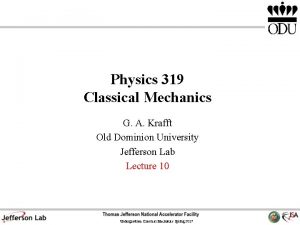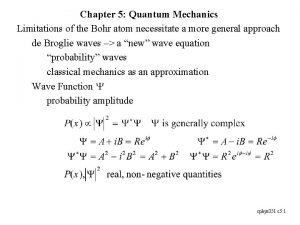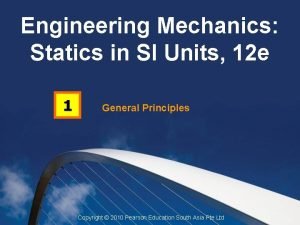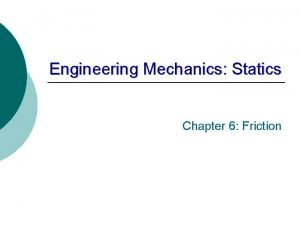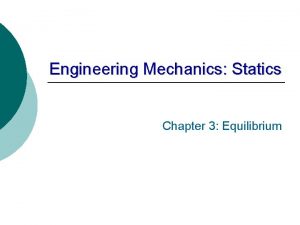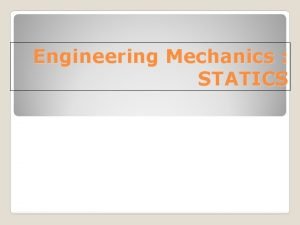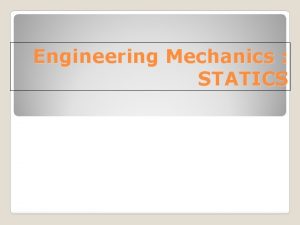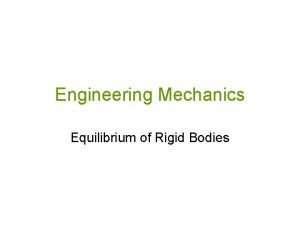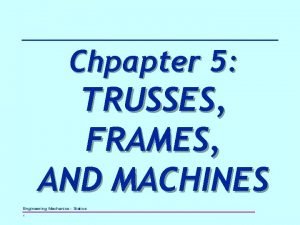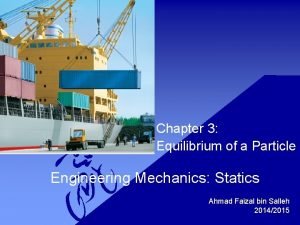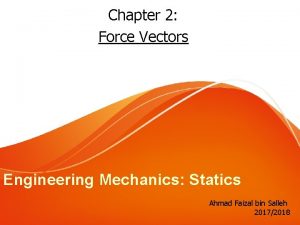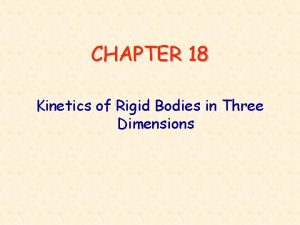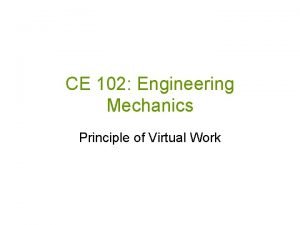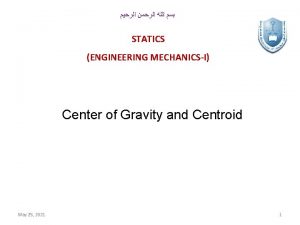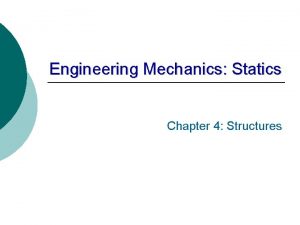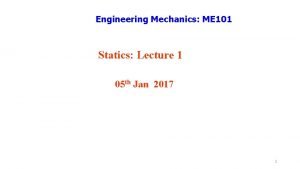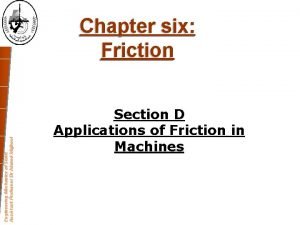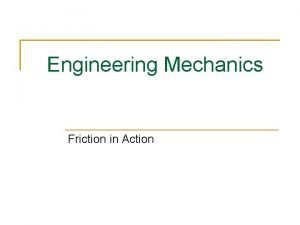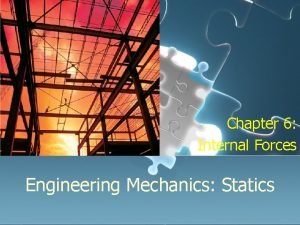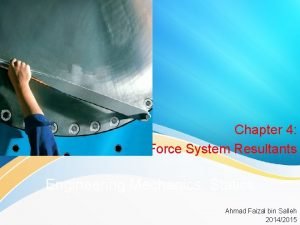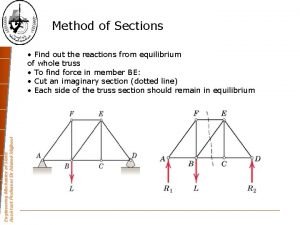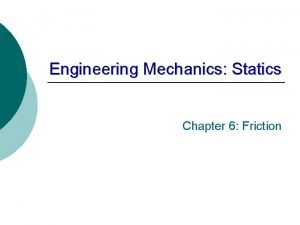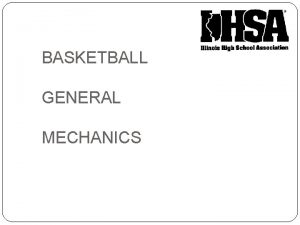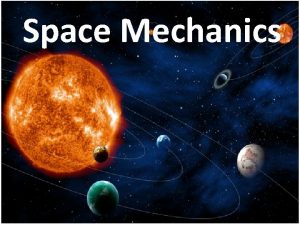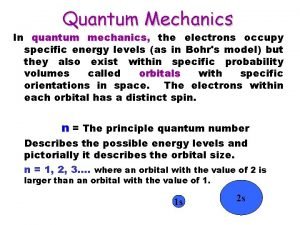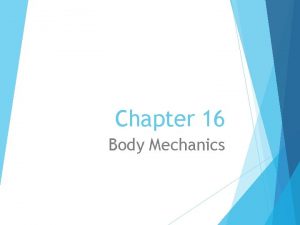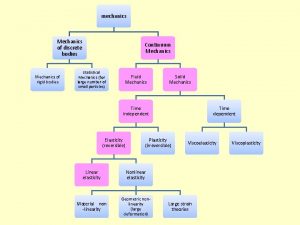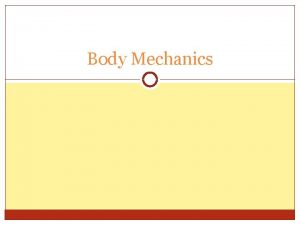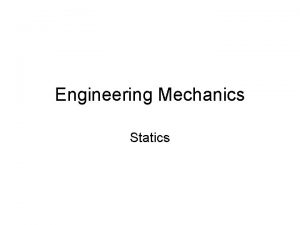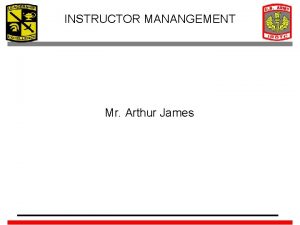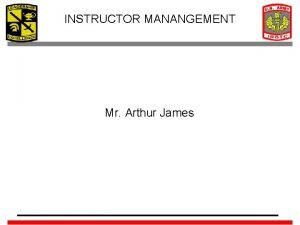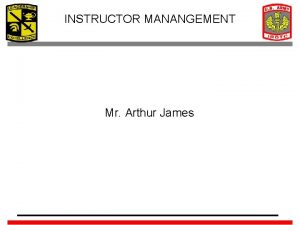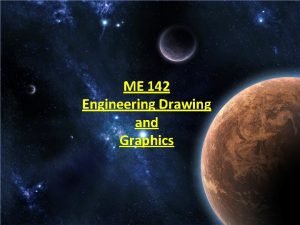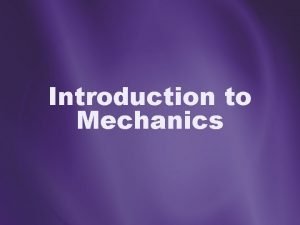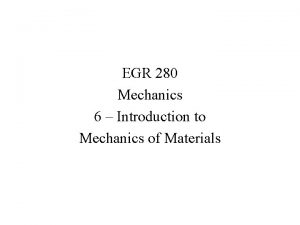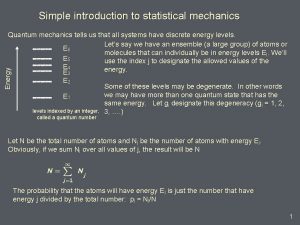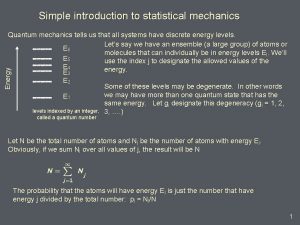Engineering Mechanics Introduction General Details n Instructor Details


























- Slides: 26

Engineering Mechanics Introduction

General Details n Instructor Details: q q n Mandar M. Inamdar Office: Civil 230, x 7314 email: minamdar AT civil. iitb. ac. in Office Hours: drop by or write to fix a time Course Location and Timings: q q Slot-11: IC 2 (SOM) n Tuesday: 3. 30 -5. 00 pm n Friday: 3. 30 -5. 00 pm (Tutorial) Slot-3 C: IC 3 (SOM) n Thursday: 8. 30 -9. 30 am We will arrange the timings properly in the coming weeks Website: http: //www. civil. iitb. ac. in/~minamdar/ce 102/

Course Objectives n We will predominantly study statics: q q n n n Involve study of methods for quantifying effect of forces between objects such that mechanical equilibrium is maintained. No real world problem is truly static: but many problems can be modeled as static problems in time/length scales of interest. Study of interactions and forces that occur in many objects of man-made world as well as in many natural phenomena. The concepts and methods in this course should give you firm grounding for your future courses on solid mechanics, fluid mechanics, kinetics and dynamics of machines. Such ideas are hoped to prepare you for solving openended questions in your profession (design or research).

Example: 1 Mechanical Engg. n Use of statics in Robotics to build evil Terminator. (http: //www. societyofrobots. com/mechanics_statics. shtml)

Example 2 Civil Engg. n The bridge should be capable of being in equilibrium while subject to self-load, wind-load etc (http: //oli. web. cmu. edu)

Example 3 Biomedical Engg. n Force applying mechanisms are applied to bones for lengthening or removing deformities. (http: //oli. web. cmu. edu)

Example-4 Computer Engg. n Hard-drives are complex mechanical systems. High magnetic forces are used to swivel recording head to required position. (http: //oli. web. cmu. edu)

Example-5 Seismology (natural phenomena) n Earthquake results because of release of pent-up up energy between two sliding tectonic plates. (http: //oli. web. cmu. edu)

Course Content n n n n Introduction, Fundamentals of Mechanics (~3 hrs) Equilibrium of 2 D and 3 D systems (~6 hrs) Truss (~3 hrs) Friction (~4 hrs) Methods of Virtual Work and Potential Energy (~5 hrs) Vibration (~3 hrs) In-class tutorials every week (~10 -15 hrs)

General Assesment Scheme Exam Weightage Date & Time Quiz-1 10% ~last week of Jan. Mid-sem 30% ~second week of Feb. Quiz-2 10% ~last week of Mar. 50% ~second week of Apr. End-sem n Syllabus for exams will be announced in class

Texts and References n n n n Texts Beer, F. P. and E. R. Johnston, Vector Mechanics for Engineers – Statics and Dynamics, Tata-Mc. Graw-Hill, New Delhi, 8 th edition (2007). Shames, I. H. , Engineering Mechanics-Statics and Dynamics, Prentice Hall India Ltd. , New Delhi, 4 th edition (1996). Merriam, J. L. and L. G. Kraige, Engineering Mechanics Vol-1 & 2, Wiley India Ltd. , New Delhi, 5 th edition (2007). General Interest Bloomfield, L. A. , How everything works: making physics out of ordinary, Hoboken: John-Wiley, 2008. General illuminating web-site about how many things around us function: http: //www. howstuffworks. com/ n I will keep adding different interesting references on the course web-site.

Some Course Policies n You have a choice between: q n n ≥ 80% attendance or XX grade/Grade Penalty. Bringing calculator to every class is a must. Please keep your cell phones on silence. If your cell phone makes noise it will be impounded and/or towed, at owner’s expense. Academic malpractice will not be tolerated. General Observations and Guidelines: q q q Please come on (or before) time. The doors will be shut ten minutes into the class (I am dead serious) I strongly encourage interactions in the class. My hope is that the class would keep you on the edge of your seats like a first-rate thriller. In case you don’t like thrillers, please sleep rather than talk/make noise.

What is Mechanics?

What’s the big deal with E. Mech? n In principle, like cricket, it’s a simple game. q n Simply, force balance and moment balance. What is the need for an elaborate course? q q q The basic rules are simple but there are many intricacies. Multi-body interactions can be very complex. A good understanding of fundamentals goes a long way in solving such complex problems. Concepts of appropriate Free Body Diagrams and equations of equilibrium (motion in dynamics) will be indispensable in later studies of mechanical engineering.

Fundamental Principles • Parallelogram Law • Principle of Transmissibility

Newton’s Laws

Newton’s Laws

Newton’s third law on a lighter note "for every action there is an equal and opposite reaction" and we shouldn't forget the laws of cause and effect, karma or whatever http: //www. kunama. com/personal/blog/2005/07/balance-of-nature. html

Systems of Units • International System of Units (SI): • Kinetic Units: length, time, mass, and The basic units are length, time, and mass which are arbitrarily defined as the meter force. (m), second (s), and kilogram (kg). Force is the derived unit, • Three of the kinetic units, referred to as basic units, may be defined arbitrarily. The fourth unit, referred to as a derived unit, must have a definition compatible with Newton’s 2 nd Law, In this course we will predominantly use SI system of units. At times we may use imperial units (length: foot, mass: pound, time: second, force: pounds/kips. Conversion of units can be easily done on your mobiles (not in class) or at: http: //www. onlineconversion. com/

Modeling Real Life Problems n n Any physical/mechanical model is simple a caricature of a real-world problem. Such a model is our way of understanding of realworld in as simple and tractable way as possible. Allows us to calculate forces/etc. , which can then be re-mapped to the real problem. The real skill is to remove unwanted flab, and get a bare-bones model, which gives a quick and reasonably accurate solution.

Example-1: Roof Truss

Another Example: Aircraft Landing Gear

Example 3 Bridge http: //oli. web. cmu. edu

Example 4 Simple basket-ball pole http: //oli. web. cmu. edu

Example-5 Ladder Climbing http: //oli. web. cmu. edu

Example-5 Draw-Bridge
 What is major details
What is major details What are the signal words
What are the signal words General mechanics
General mechanics General mechanics
General mechanics Pearson education south asia pte ltd
Pearson education south asia pte ltd Cone of friction in engineering mechanics
Cone of friction in engineering mechanics Equilibrium engineering mechanics
Equilibrium engineering mechanics Statics
Statics Centroid engineering mechanics
Centroid engineering mechanics Center of gravity statics
Center of gravity statics Free body diagram in engineering mechanics
Free body diagram in engineering mechanics Difference between trusses and frames
Difference between trusses and frames Particle equilibrium in 2d and 3d engineering mechanics
Particle equilibrium in 2d and 3d engineering mechanics Solve the vector product of 100j x 100k =?
Solve the vector product of 100j x 100k =? Kinetics of a rigid body
Kinetics of a rigid body Virtual work mechanics
Virtual work mechanics Centroid and centre of gravity in engineering mechanics
Centroid and centre of gravity in engineering mechanics Statics of structures
Statics of structures Me 101 engineering mechanics
Me 101 engineering mechanics Centroid engineering mechanics
Centroid engineering mechanics What is β in the equation t2 = t1eµβ
What is β in the equation t2 = t1eµβ Friction engineering mechanics
Friction engineering mechanics Internal forces statics
Internal forces statics Force system resultants chapter 4
Force system resultants chapter 4 Engineering mechanics
Engineering mechanics The truss used to support a balcony is subjected to
The truss used to support a balcony is subjected to Friction chapter in engineering mechanics
Friction chapter in engineering mechanics


